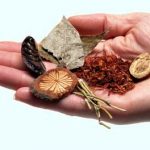Chinese Herbal Medicine (中药) Posted by Stephen on Jan 17, 2012 in Uncategorized
 A cornerstone to Chinese traditional medicine is herbal medicine or 中药 (Zhōng yào). Chinese herbal medicines are made from plants, herbs, and occasionally from the organ meats of a wide range of exotic (and strange) animalia. Medicines are typically constructed from ingredients found in the natural world, and are mixed in accordance Traditional Medicine Theory to stimulate certain organ systems or to balance out the undesired aspects of other materials used. Most medicines come in dried form to be steeped into a tea, after being ground up in mortars and tinctures.
A cornerstone to Chinese traditional medicine is herbal medicine or 中药 (Zhōng yào). Chinese herbal medicines are made from plants, herbs, and occasionally from the organ meats of a wide range of exotic (and strange) animalia. Medicines are typically constructed from ingredients found in the natural world, and are mixed in accordance Traditional Medicine Theory to stimulate certain organ systems or to balance out the undesired aspects of other materials used. Most medicines come in dried form to be steeped into a tea, after being ground up in mortars and tinctures.
Chinese traditional medicine practitioners may suggest herbal remedies as dietary change, adding certain organ meats or herbs to meals to enhance the patient’s overall balance and harmony. There are roughly 13,000 medicinals used in China and over 100,000 medicinal recipes recorded in the ancient literature.
Practice (作法)
Chinese Herbology or 中药学 (zhōngyào xué) or 中药 (zhōngyào), is the study of ingestible natural ingredients and their observable effects on the human body. It includes the basic theory of “crude medicine,” “prepared drug in slices” called 饮片 (yǐnpiàn) along with the collection and preparation, performance, efficacy, and clinical applications of these drugs on individual patients.
Each herbal medicine prescription is a cocktail of many herbs tailored to the individual patient. One batch of herbs is typically decocted twice over the course of one hour. The practitioner usually designs a remedy using one or two main ingredients that target the illness. Then the practitioner adds many other ingredients to adjust the formula to the patient’s yin/yang conditions.Some herbs require the use of other ingredients as catalyst or else the brew is considered to be ineffective. Unlike western medications, the balance and interaction of all the ingredients are considered more important than the effect of individual ingredients.
Misuse and Controversy (争议)
 Animal products are used in certain Chinese medicine mixtures causing many conservationists, vegans and vegetarians to lash out at the practice. Unfortunately, the use of rare and endangered species in Chinese medicine has increased, forcing the destruction of vital habitats and the near extinction of species. If informed of such restrictions, practitioners can often use alternative substances.
Animal products are used in certain Chinese medicine mixtures causing many conservationists, vegans and vegetarians to lash out at the practice. Unfortunately, the use of rare and endangered species in Chinese medicine has increased, forcing the destruction of vital habitats and the near extinction of species. If informed of such restrictions, practitioners can often use alternative substances.
Ecological effects are greater than just on the species used in Chinese traditional medicine. For example, the worldwide shark population has been devastated to a small fraction of its original population by a growing demand for shark fin soup. Once considered only for rare occasions, with a growing Asian middle class, there is an accompanying demand for shark fin. Other instances of hunting endangered species for medicinal properties include the use of ground up tiger bone for impotency, rhinoceros horn used for fever, and black bear bile for the treatment of cirrhosis and other kidney/liver diseases.
Currently, the Chinese government is clamping down on illegal poaching and sale of these endangered animals, but corruption and demand have impeded progress.

Build vocabulary, practice pronunciation, and more with Transparent Language Online. Available anytime, anywhere, on any device.
About the Author: Stephen
Writer and blogger for all things China related. Follow me on twitter: @seeitbelieveit -- My Background: Fluent Mandarin speaker with 3+ years working, living, studying and teaching throughout the mainland. Student of Kung Fu and avid photographer and documentarian.




Comments:
Herbal Obsession:
I like your post you provide some useful info to us about the Chinese Herbal Medicine!!!